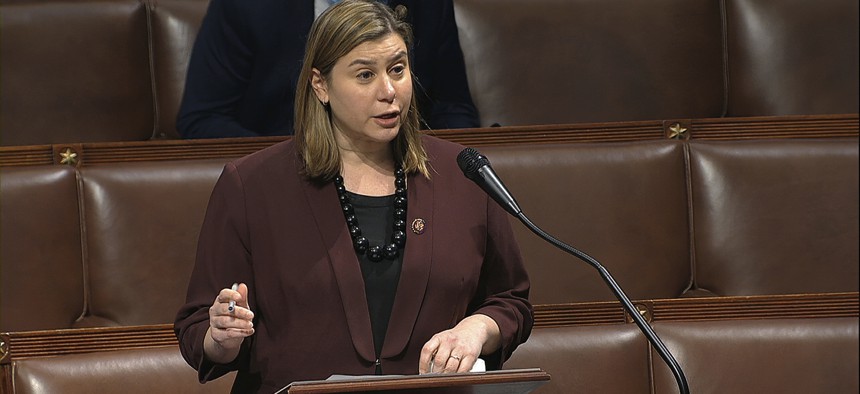Defense Task Force Will Focus on Legislative Solutions for Supply Chain Chokepoints

House Television/AP Photo
Reps. Elissa Slotkin, D-Mich., and Mike Gallagher, R-Wisc., are leading the three-month task force.
A new task force will look for legislative tools that could be included in the next National Defense Authorization Act to ensure the Defense Department is protected from vulnerabilities created by unstable supply chains.
House Armed Services Committee leaders last week announced the formation of the Defense Critical Supply Chain Task Force, which will operate for three months and create a concise report pulling together ideas for legislative fixes to shore up the defense supply chain. Reps. Elissa Slotkin, D-Mich., and Mike Gallagher, R-Wisc., who head the task force, outlined their vision for the task force during a Wednesday press call.
“Back in April and May, I really feel like I was in a version of the Star Wars cantina where I was walking around and everybody was coming up and saying, ‘I got a guy who can get you masks and I got a guy who can get you this,’” Slotkin said of the COVID-19 pandemic. “And that's just not the way we want to ever be left open again.”
The task force functions as a sort of legislative companion to executive branch efforts covering the same topic. President Joe Biden recently signed an executive order requiring reviews of critical supply chains, including for the defense industrial base and information and communications technologies sectors.
“Making sure that we are working as much as possible with the administration as they look at these executive orders that have now been tasked at what they can do from the executive branch, we want to be moving out on what we can do on the legislative side,” Slotkin said.
The first step the task force will take is to work with DOD to identify what supplies are actually critical, Slotkin said. She anticipates this critical supply list will range from equipment like masks and gloves to higher-end technologies like semiconductors and certain batteries—anything DOD requires to execute its varied missions.
Gallagher said the current supply chain situation is “even less tenable” when it comes to critical technologies, highlighting China’s dominance in drone production and electronics manufacturing. He raised concerns about an “extreme geographic concentration” in and around China when it comes to integrated circuit production.
“...In a crisis, the [Chinese Communist Party] could effectively shut off our ability to procure the building blocks of the advanced technologies that drive our national defense in our civilian economy,” Gallagher said.
While alleviating chokepoints in critical supply chains is a main focus of the task force, Gallagher also said China’s dominance over certain supply chains gave it a powerful coercive tool.
“So we dealt with this in the 5G debate and Huawei and ZTE,” Gallagher said. “It wasn't just a matter of Huawei and ZTE technology allowing the CCP to spy on people around the world, it was them being able to use that dominant market position in 5G in order to either shut down networks or coerce other countries into doing their bidding.”
The task force will pull from existing ideas around solving the supply chain problem that could be turned into legislation for the next NDAA. Gallagher mentioned the Cyberspace Solarium Commission, which he co-chaired, as a source from which the task force may pull. When asked about another high-profile commission—the National Security Commission on Artificial Intelligence—Slotkin and Gallagher said they looked forward to stealing their best ideas and recommendations where appropriate for the task force.
The HASC cyber and information systems subcommittee will meet jointly with the House Oversight and Reform Committee Friday to hear testimony from NSCAI co-chairs Eric Schmidt, former Google chief executive, and Robert Work, former deputy defense secretary, and other commissioners on the group’s final report.
NEXT STORY: House passes Rescue package with TMF funding






